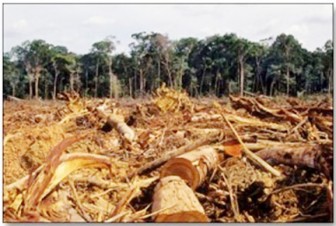The July 1 to 15 Tropical Timber Market (TTM) Report produced by the International Tropical Timber Organization (ITTO) has raised concerns over the level of wood waste generated by the timber industry in neighbouring Brazil owing to inefficient harvesting and processing procedures.
Brazil reportedly consumes around 17 million cubic metres of wood per year.

According to the report, while harvests of tropical timber from the Amazon are in the region of 2.5 million cubic metres annually, it is estimated that only around 1.5 million cubic metres are used for construction, furniture manufacturing and other economic pursuits, the remainder is unaccounted for.
In Sao Paulo, where most of the timber is consumed, a consumer awareness programme titled “wood is legal” has been launched to encourage domestic consumers to purchase wood from proven legal sources and to promote the use of legally sourced timber in the construction industry.
“The Brazilian authorities recognize that, at present, it is difficult to separate wood that comes from forests managed to approved standards and that from illegal logging. By encouraging timber companies to commit themselves to reduce waste and to adopting more efficient technologies and at the same time encouraging consumers to demand to know the origin of the timber they purchase, the level of illegal harvesting can be reduced and the level of processing efficiency can be improved,” the report says.
Meanwhile, it adds that information gathered by the National Institute for Space Research (INPE) reveals that the deforestation in the Amazon fell in May compared to April 2011. Information gathered pointed to a decrease of more than 200 sq km in the area deforested, according to the Brazilian Ministry of Environment. The report attributes the reduced deforestation to tough measures adopted in March and April of this year by the Crisis Office set up by the Brazilian Institute of Environment and Renewable Natural Resources (IBAMA), The activities of the office, the report says, resulted in intensification of efforts to combat illegal logging by the Federal Police, the Federal Highway Police, the National Security Force and the army. Additionally, the number of satellite deforestation alerts issued doubled as the sky was clear and the satellites were able to more accurately to capture the images of deforestation in the Amazon.
In one area of Brazil, the state of Moto Grosso, where severe deforestation had been recorded, 400 inspectors were posted. This state continues to account for the highest rates of deforestation.
In May, 94 sq km were deforested in Mato Grosso, equivalent to 35 per cent of the total Amazon deforestation. The second worst level was recorded in the state of Rondônia where the rate was around 67 sq km.
INPE reported that in May 2011 the rate of deforestation in the Amazon exceeded the levels in May in 2009 and 2010.
Brazil currently accounts for 2% of the world furniture production, occupying 13th position in the ranking of largest furniture producers and 30th in the ranking of expor-ters. The four largest furniture exporters in the world continue to be China, Italy, Germany and Poland.





